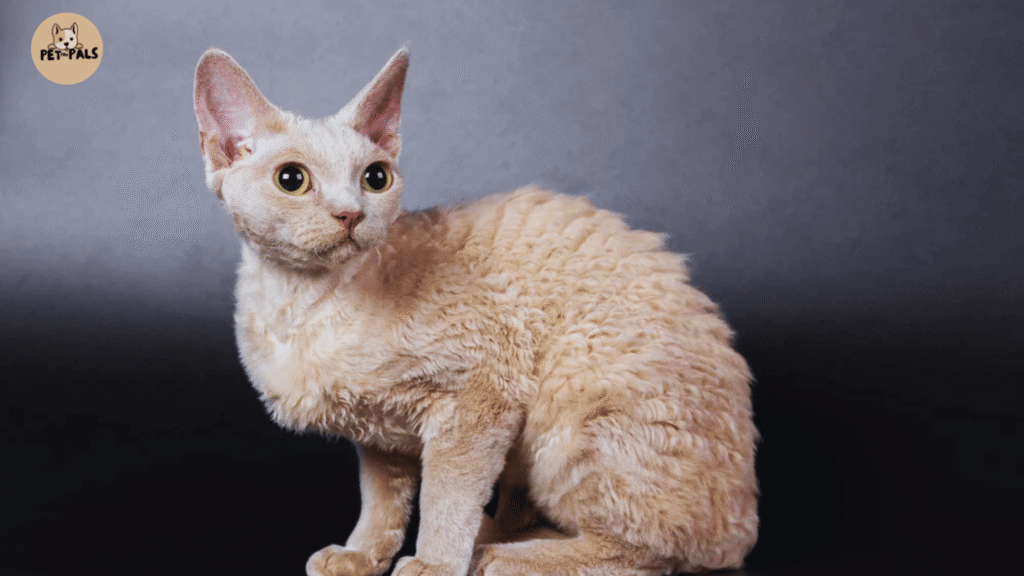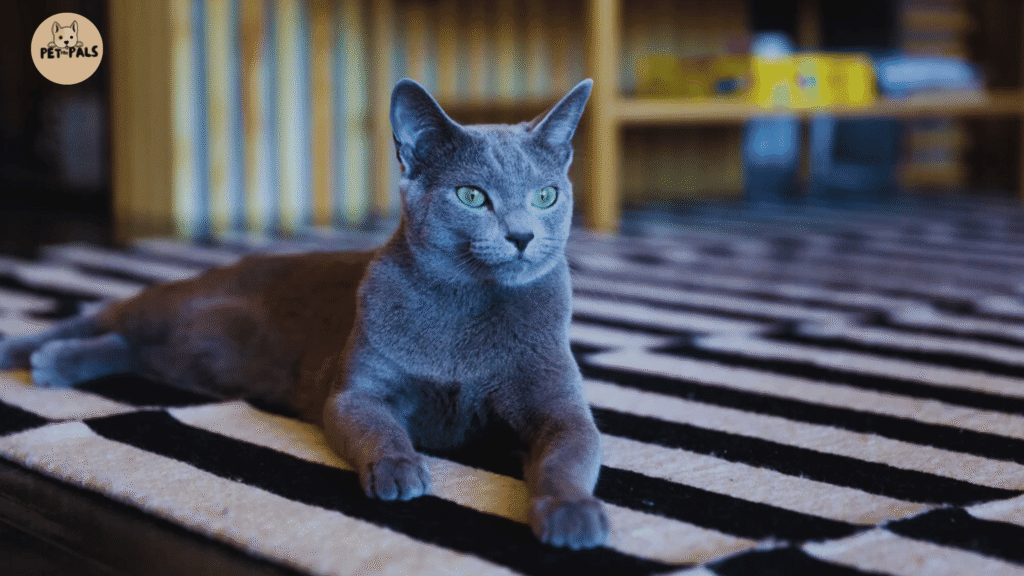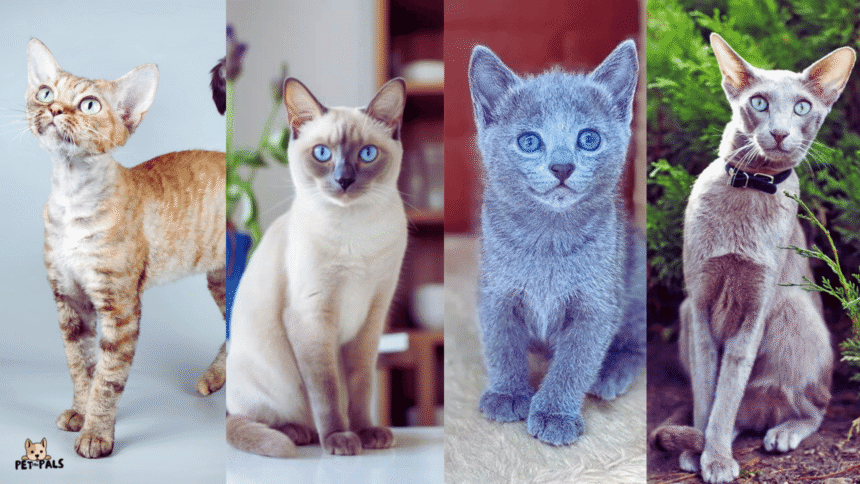For all their charm and cuddles, cats come with one pesky side effect: fur, and lots of it. From your sofa to your sweaters, cat hair seems to magically appear everywhere. According to the American College of Allergy, Asthma, and Immunology, cat dander is one of the most common indoor allergens, affecting up to 20% of the population.
Constant cleaning, sneezing fits, and air purifiers on full blast can make even the most devoted cat lover dream of a tidier alternative. But here’s the good news: some cat breeds naturally shed far less. Whether you’re managing allergies or just want to keep a spotless home, some cats don’t leave a trail of fur behind.
Let’s explore the best low-shedding cat breeds that offer all the affection, with much less mess.
Why Some Cats Shed Less Than Others
If you’ve ever wondered why some cats leave tumbleweeds of fur behind while others barely shed at all, the answer lies mostly in their genetics and coat type. Just like people have different hair textures and growth cycles, cats do too, and some breeds are naturally lower maintenance when it comes to shedding.
Genetics & Coat Type
Certain short-haired cat breeds have coats that shed minimally because they lack the thick undercoat common in heavy-shedding cats. Breeds like the Siamese or the Russian Blue, for example, have fine, sleek fur that tends to stay put rather than float around your home.
Single vs. Double Coats
One key difference is whether a cat has a single or double coat. Double-coated cats, like Maine Coons or Persians, have a soft, fluffy underlayer beneath their outer fur, which sheds heavily, especially during seasonal changes. On the other hand, cats that don’t shed much often have just a single coat, meaning there’s less fur to lose in the first place.
The Role of Grooming
Even nonshedding cats still need grooming, but much less of it. Regular brushing helps distribute natural oils and remove loose hairs before they hit your couch. Plus, grooming is a great way to bond with your cat while keeping their coat healthy and clean.
Top 7 Low-Shedding Cat Breeds
If you’re dreaming of a clean home without giving up the joy of a feline companion, these low shedding cat breeds might be the perfect match. They’re known for minimal fur loss, lower dander, and easy grooming, ideal for tidy households and allergy-sensitive families.
1. Devon Rex

With its curly, fine coat and elfin-like appearance, the Devon Rex is a true standout among minimal shedding cats. This breed has very little fur and almost no guard hairs, which means shedding is practically nonexistent.
Its soft, wavy coat is easy to care for and rarely needs more than a light brushing. The Devon Rex is a short-haired, low-shedding cat breed that’s perfect for those who want a tidy home without sacrificing personality.
Playful, people-oriented, and full of energy, these cats love snuggling up and being involved in every part of your day. For allergy-prone households, the Devon Rex offers affection, charm, and cleanliness in one low-maintenance package.
2. Russian Blue

The Russian Blue has a plush, silvery-blue coat that looks thicker than it is. Thanks to a dense yet single-layered coat, they’re surprisingly low-shedding. These elegant and gentle cats produce less of the glycoprotein Fel d 1, the allergen found in cat saliva and skin, which may also make them easier on allergy sufferers.
Grooming is a breeze, with just occasional brushing needed to keep their fur in top shape. With their calm, quiet nature and natural cleanliness, Russian Blues are ideal for homes where peace and tidiness are top priorities.
3. Bengal Cat
The Bengal may look like a wild jungle cat, but this breed is one of the non-shedding cats that surprises many. Their short, dense, and pelt-like coat doesn’t shed much, and it has a smooth texture that requires very little maintenance.
Bengals are also famously active, intelligent, and curious. They need plenty of play and stimulation. While they’re not lap cats in the traditional sense, they love interacting with their humans. If you’re after a low-shedding breed with energy to spare and stunning, exotic looks, the Bengal is a great fit.
4. Cornish Rex Cat
The Cornish Rex has a coat like no other, soft, curly, and made up of only the undercoat layer, known as down. This unique trait makes them one of the best cats that don’t shed. Because they lack both the guard hairs and outer coat that most cats have, there’s very little fur to shed in the first place.
These cats are playful, quirky, and highly affectionate, often acting more like puppies than traditional felines. Light brushing every week or two is all they need. If you’re looking for a loving, low-fur housemate, the Cornish Rex is a standout.
5. Siamese Cat
Sleek, elegant, and incredibly social, the Siamese cat is one of the most popular short haired cat breeds and for good reason. With their fine, close-lying coats, Siamese cats shed very little compared to fluffier breeds. They don’t have a dense undercoat, which means fewer loose hairs floating around.
Their grooming needs are minimal, often just a quick weekly brushing. Siamese cats are also known for being vocal and affectionate, often forming strong bonds with their people. If you’re looking for a low-maintenance, low-shedding companion that loves conversation, the Siamese is a beautiful and tidy choice.
6. Sphynx Cat
Famous for being hairless, the Sphynx is often the first breed people think of when they hear “non-shedding cats.” While they technically don’t shed, Sphynx cats still need regular care, including weekly baths to remove oil buildup on their skin.
But for those with allergies or a strong dislike for pet hair on furniture, the Sphynx can be a great option. These cats are affectionate, curious, and love warmth; you’ll often find them curled up under blankets or sunbathing. With proper skincare, Sphynx cats are tidy, loving pets with big personalities.
7. Oriental Shorthair Cat
A cousin of the Siamese, the Oriental Shorthair shares that same sleek body, big ears, and fine coat that sheds minimally. With over 300 color and pattern variations, this breed combines beauty with practicality.
Their short, close coat needs very little brushing, and they don’t have the thick undercoat associated with heavy shedding. Orientals are also known for being social, vocal, and intelligent; they love being the center of attention. If you want a cat that’s easy to groom and full of character, the Oriental Shorthair delivers both.
Tips to Reduce Shedding Even More
Even if you choose a low-shedding cat breed, some fur is bound to show up now and then; it’s just part of being a cat parent. The good news? A few smart habits can go a long way toward keeping your home clean and your cat’s coat healthy. Here are some simple, effective cat grooming tips to help reduce cat shedding even more.
Brush Regularly
Brushing is one of the easiest ways to keep loose fur under control, even for short-haired cats. A quick brush once or twice a week helps remove dead hair, stimulates healthy skin, and cuts down on the amount of fur that ends up on your clothes or couch.
Feed a Balanced Diet
A shiny coat starts from the inside. Make sure your cat is eating a high-quality, protein-rich diet that includes omega-3 fatty acids, which support skin health and reduce excess shedding. Always talk to your vet before adding supplements, but fish oil or omega-3s can work wonders.
Use the Right Tools
Keep a lint roller or grooming glove handy, especially during shedding season. Grooming gloves are great for gently collecting loose fur while giving your cat a massage they’ll love. They’re also perfect for cats that aren’t fans of traditional brushes.
Clean Smart
Vacuum regularly and use washable covers on furniture to make cleanup easier. A de-shedding tool like the Furminator (for cats that tolerate it) can also help reduce the amount of fur in your home.
By combining these easy grooming habits with a naturally low-shedding breed, you can enjoy all the cuddles without all the clean-up.
Are Low-Shedding Cats Good for Allergy Sufferers?
It’s a common belief that cats that don’t shed are automatically allergy-friendly, but it’s not that simple. While low-shedding cat breeds leave less fur around your home, the true culprit behind most cat allergies is a protein called Fel d 1, which is found in a cat’s skin, saliva, and dander, not just their fur.
That said, cats that shed less often spread fewer allergens throughout the home. Some breeds, like the Russian Blue, are even known to produce less Fel d 1, making them a better option for allergy sufferers, though not entirely hypoallergenic.
So while non-shedding cats won’t eliminate allergies, they can significantly reduce symptoms in many cases. With smart grooming habits and a tidy home, allergy-prone cat lovers can still enjoy a furry friend, just with fewer sniffles.
Where to Find These Breeds?
Once you’ve fallen in love with a low-shedding cat breed, the next step is finding your future feline responsibly. Whether you’re looking for a playful Devon Rex or a regal Russian Blue, it’s important to adopt or buy from ethical sources.
Choose Reputable Breeders
If you’re going through a breeder, always do your homework. Reputable breeders will prioritize the health, temperament, and welfare of their cats. They should be transparent about the kitten’s lineage, offer health guarantees, and allow you to visit the environment where the cats are raised.
Check Petfinder & Breed-Specific Rescues
Many people are surprised to learn that non-shedding cats or specific breeds occasionally turn up in shelters or rescue groups. Websites like Petfinder often list cats by breed, age, and location. You can also look into breed-specific rescues (e.g., “Balinese Cat Rescue”) that specialize in rehoming certain types of cats.
Adopt Ethically
Whether you adopt or buy, your new cat deserves a safe, loving home. Avoid kitten mills, backyard breeders, or online sellers with little to no background information. Taking the time to adopt ethically ensures your cat is healthy and happy, and that you’re not supporting inhumane breeding practices.
Bringing home a cat is a long-term commitment, so take your time, ask questions, and make sure the match is right both for you and your future feline friend.
Final Thoughts
Living with a cat doesn’t have to mean constant fur cleanup or allergy flare-ups. With the right breed and a few simple cat grooming tips, you can enjoy all the cuddles and companionship, minus the mess. From the quirky Devon Rex to the elegant Russian Blue, low-shedding cat breeds offer the perfect balance of beauty, personality, and practicality.
Just remember: while cats that don’t shed as much can help reduce allergens, they’re not entirely hypoallergenic. Every cat is unique, and choosing one should always come down to more than just coat type think lifestyle, temperament, and your ability to provide a loving home.
Whether you adopt from a shelter or connect with a reputable breeder, the goal is the same: find a feline companion who fits your world and leaves only paw prints behind.
Frequently Asked Questions
Do low-shedding cats mean no allergies?
Not necessarily. Low-shedding cats produce less loose fur, but allergies are mainly caused by a protein called Fel d 1 found in dander and saliva. While low-shedding breeds can reduce allergen spread, they’re not completely hypoallergenic.
Are low-shedding cats easier to groom?
Generally, yes! Cats with less fur usually require less brushing and grooming. Breeds like the Devon Rex have short, fine coats that are simple to maintain, making them great for busy owners.
What is the most low-maintenance cat breed?
Breeds like the Sphynx (hairless) and Devon Rex are among the easiest to care for in terms of grooming and shedding. However, each cat’s personality and health needs also play a big role.
Which cat breed sheds the least?
The Devon Rex, Russian Blue, and Balinese are all known for minimal shedding. Hairless breeds like the Sphynx technically don’t shed at all but need other care like regular skin cleaning.

